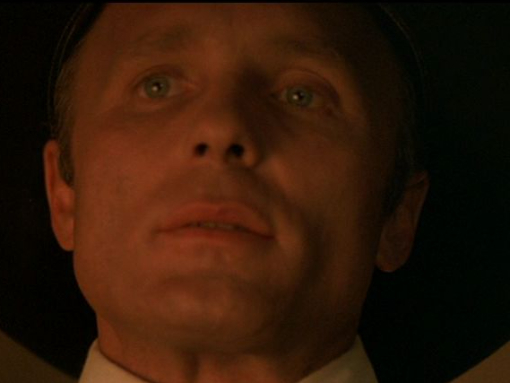To Sleep with Anger

See more details, packaging, or compare
Synopsis
A slow-burning masterwork of the early 1990s, this third feature by Charles Burnett is a singular piece of American mythmaking. In a towering performance, Danny Glover plays the enigmatic southern drifter Harry, a devilish charmer who turns up out of the blue on the South Central Los Angeles doorstep of his old friends. In short order, Harry’s presence turns a seemingly peaceful household upside down, exposing smoldering tensions between parents and children, tradition and change, virtue and temptation. Interweaving evocative strains of gospel and blues with rich, poetic-realist images, To Sleep with Anger is a sublimely stirring film from an autonomous artistic sensibility, a portrait of family resilience steeped in the traditions of black mysticism and folklore.
Picture 9/10
Last released back on home video on LaserDisc in VHS in the early 90s, Carl Burnett’s To Sleep with Anger enters the Criterion Collection with this Blu-ray edition sporting a brand-spanking-new 4K restoration, scanned from the 35mm original camera negative. The films is presented in its original aspect ratio of 1.85:1 on a dual-layer disc, with a 1080p/24hz high-definition encode.
It’s knockout of a presentation, making the extra long wait for a North American release of the film (on not only Blu-ray but DVD as well) more worthwhile. It has a real nice filmic consistency to it, rendering the film’s dense grain about as perfect as the format can. Outside of a handful of shots the details are always crisp and clean, from close-ups to long shots. It is a more subdued film in terms of its colour scheme, featuring a darker palette, but they still manage to look extraordinary here, perfectly saturated and even vibrant at times. There can be some mild crush in some of the interiors (and it could be a byproduct of the photography) but black levels are otherwise also superb, staying deep while holding on to most of the details.
Restoration wise I never noticed a single blotch or blemish at any time. In all the film looks like it could have been made just in the last few years instead of almost 30 years ago.








































Audio 8/10
The film includes a DTS-HD MA 2.0 surround presentation. It’s a dialogue heavy film, with the audio primarily focused to the fronts, but some sound effects and the film’s Blues score and soundtrack fill out the rest of the environment. It also all sounds crisp and clean, without any distortion or noise, with good fidelity and range. It won’t show off much of anything but it still sounds excellent.
Extras 6/10
At first glance the supplements are a bit disappointing since there are only three on-disc features to be found. Though I’ll admit I wish there was more here, the material ended up being surprisingly meaty, one feature being a real standout.
First is the new 24-minute documentary Of Family and Folklore, featuring interviews with director Charles Burnett, associate producer Linda Koulisis, and actors Danny Glover and Sheryl Lee Ralph. As far as making-ofs with talking-heads go this doesn’t break any new ground: it covers the span of the production from its inspiration, to the script, to casting, to shooting, and then release. But the film has a rather interesting (and surprisingly lengthy) production history, with Danny Glover’s interest in the script being what finally got it made since the Lethal Weapon star attracted more investors. But what makes this supplement special is getting the more personal insights, especially from Glover and Ralph, who talk about their characters and what the film means to them. Burnett also covers the influences behind the film, the folklore elements, and more.
Criterion has then licensed the Charles Burnett Tribute created for the Governors Awards by the Academy of Motion Picture Arts and Sciences. It’s a short 6-minute piece featuring Burnett and a number of performers, filmmakers and others in the industry talking about Burnett and his influence.
The big feature on here, though, is A Walk with Charles Burnett, featuring Burnett and filmmakers Robert Townsend revisiting locations from both Killer of Sheep and To Sleep with Anger, as well as his childhood home and neighbourhood. While visiting these locations and talking about the respective films they also talk about Burnett’s childhood, what pushed him to get into filmmaking, and his memories of specific events in L.A., like the riots. They also talk about specific scenes and elements (like the music) in his two films. He also talks about his honorary Oscar and what he hopes it might do for him. It’s a wonderful discussion that offers an incredibly dense look into his career, and manages to fly by, even at 56-minutes.
Sadly, Criterion doesn’t bring in any academics to talk about the film, outside of the essay by Ashley Clark, found in the poster insert that has been included (the one side presents the essay while the other presents the new cover art). So, no, there isn’t a lot, but I’m hoping that maybe this is a sign they will be able to get their hands on Killer of Sheep and they’re saving material for that edition.
Closing
I would have expected a bigger special edition but disappointingly that’s not the case. Still, finally having this film in an otherwise solid edition after all these years is good enough. It looks and sounds fantastic and it comes highly recommended just for this aspect alone.







